Valour
All the members of the Lodge have enjoyed distinguished military careers and the Sovereign has acknowledged the outstanding bravery in action of a select few. Lodge details have been added for information in italics.
The Distinguished Conduct Medal (D.C.M.)
The Distinguished Conduct Medal was introduced by Royal Warrant in 1854 for acts of bravery by non-commissioned ranks of the Army. Two years later these were specified as acts of bravery, which did not quite deserve the award of the Victoria Cross (V.C.).
The medal bears an effigy of the Sovereign with the words “For Distinguished Conduct in the Field” on the reverse. It is hung from a scroll clasp with a red and blue ribbon.
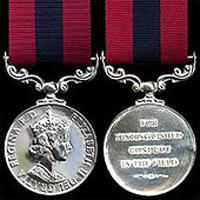
The following Brother was awarded the D.C.M.: -
Bro. B. Faulkner (3 Para.) I – 1994
C/Sgt Brian Faulkner was awarded the D.C.M. for his actions in the battle of Mount Longdon during the Falklands War (London Gazette – 10th November 1982), while serving with 3 Para.
On observing a group of Argentinian Marines advancing towards his Regimental Aid Post on the western slope of the mountain and realising that some 20 wounded Paratroopers were about to be captured (or worse) he deployed anyone fit enough to defend the position. He relates that he: "… … picked three or four blokes and got up on a high feature. As I did so, a group of twenty or thirty Argentines came towards us. We just opened fire on them. We don't know how many we killed, but they got what they deserved because none of them were left standing when we had finished with them”.

Brian Faulkner left the Army in 1989 having achieved the rank of C.S.M.
Military Medal (M.M.)
The Military Medal was instituted on 25th March 1916 for acts of bravery, not of sufficient heroism as to merit the D.C.M., carried out by non-commissioned ranks of the Army, including the Royal Flying Corps and the Royal Naval Division.
The medal bears an effigy of the Sovereign with the words “For Bravery in the Field” on the reverse. It is hung from an ornate scroll with a blue ribbon with five equal narrow central stripes of white, red, white, red and white.
.png)
The following Brethren were awarded the M.M.: -
Bro. N. Ross (156 Para.) F - 1990
Bro. R.A. Reiber (5 (Scottish) Para.) J - 2001
Lance-Corporal Noel Rosenberg (he changed his name to Ross in 1951) dropped with 156 Para. on 18th September 1944 as part of Operation “Market Garden”. His Bn were deployed to secure the high ground north of Arnhem in an effort to halt the approaching German forces. With wireless communications practically non-existent, Rosenberg volunteered to carry messages. As he moved about he was continuously under fire and killed many of the enemy. He later said: “I didn’t see them as men, only as targets.” With 156 Para. reduced to a third of its strength just 36 hours after landing, the remainder had to fight for survival, and Rosenberg was regularly heard encouraging others. He was so dependable that he was promoted in the field to Sergeant by his Company Commander, Major Geoffrey Powell, who subsequently commanded what was left of the Battalion.
Rosenberg was particularly conspicuous during 4 Para. Bde’s withdrawal to the 1st A/B. Div’s defensive perimeter at Oosterbeek. When a wooded hollow had to be cleared Major Powell decided on a seemingly suicidal charge. Rosenberg directed devastating covering fire on the enemy by giving clearly shouted fire orders, simultaneously disposing of two of the enemy, who suddenly emerged from behind a bush. By now surrounded, the Bde Commander decided on a desperate second charge to reach the defensive perimeter, ordering Powell to select a man for covering fire. Rosenberg was that soldier and was given a Bren gun, 12 magazines, six hand grenades and six phosphorous grenades for the task, which he duly carried out with devastating effect. Powell and his men were then ordered to withdraw to the Rhine for evacuation and Rosenberg was detailed, with another man, to find a boat. This involved getting into the river and sinking to shoulder level to avoid a patrol. Powell eventually managed to get his men across, but because the boat was full, Rosenberg and his comrade had to hang on to the stern.
After these actions Rosenberg was awarded the MM – he had initially been recommended for a DCM.
He had previously been Mentioned in Dispatches in North Africa.
In 1964 Ross was posted to the Far East Training Centre in Singapore, where he was involved in the Borneo Confrontation, and with only a small staff handled the repatriation of some 45,000 soldiers from 15 nations. Ross was instrumental in helping the smooth dispatch of large numbers of these troops from the Far East to Britain and he was awarded a B.E.M. (Supplement London Gazette 1st January 1968).
He left the Army in 1974, having achieved the rank of C.S.M.
He settled in Aldershot and worked as an Army Welfare Housing Officer until he retired in 1996.
.png)
Above >>>
Noel Ross (Rosenberg)
Robert Reiber enlisted initially in the 1st Bn the Tyneside Scottish (Black Watch – Royal Highland Regt) and volunteered for the airborne forces in 1943. After his parachute training he joined 5 (Scottish) Para. and saw active service in Italy, Southern France, Greece and Palestine.
His M.M. was awarded for gallantry while a Sergeant during Operation Manna in Greece in 1944/45 (Supplement London Gazette – 10th May 1945).
Initially 2 Ind. Para Bde, consisting of 4, 5 and 6 Para. were dropped in Greece with the aim of harassing the German Forces as they withdrew from the Balkans. However, they were soon involved in vicious fighting against Greek Communist rebels as that country descended into what amounted to Civil War.
Because of his Swiss parentage he was nicknamed “The Baron”.
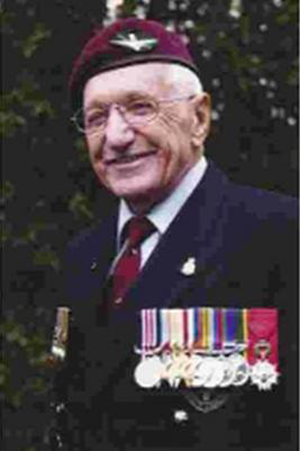
Above >>> Robert “The Baron” Reiber
Mentioned in Dispatches (M.I.D.)
A soldier mentioned in dispatches is one whose name appears in an official report written by a superior Officer and sent to the High Command, in which his gallant or meritorious action in the face of the enemy is described. The award is acknowledged by an oak leaf superimposed on the Campaign Medal awarded for the conflict in which the action occurred.

The following Brethren were awarded a M.I.D.: -
Bro. N. Ross 156 Para. F - 1991
Bro. R.A. Stacey 2 Para. I - 1996
Cpl Richard Stacey was mentioned in despatches while serving with 2 Para. in Northern Ireland in 1994 (London Gazette – 22nd November 1994).
He was on duty in the New Lodge area of North Belfast when his patrol was ambushed and came under fire. A female member of the R.C.M.P. was hit three times. Cpl Stacey rapidly chased through the contact point smashing and diving through the window of the house from which the shots had come. He cleared the ground floor, secured the weapon that had been used by the gunman and then apprehended two known terrorists as they attempted to leave through the rear garden. After handing them over for arrest by the RUC he returned through the house and briefed the Commander of the cordon that had secured and sealed off the area. While he was doing so a device exploded within the building destroying most of its frontage and causing serious damage to neighbouring properties. No doubt the occupants had been moved out before the terrorists set up their ambush and “come on”, but this again demonstrated their total disregard for the lives and wellbeing of the people they claimed to defend.
Luckily there were no further casualties.
As a result of his prompt action two wanted men were apprehended and a weapon retrieved.
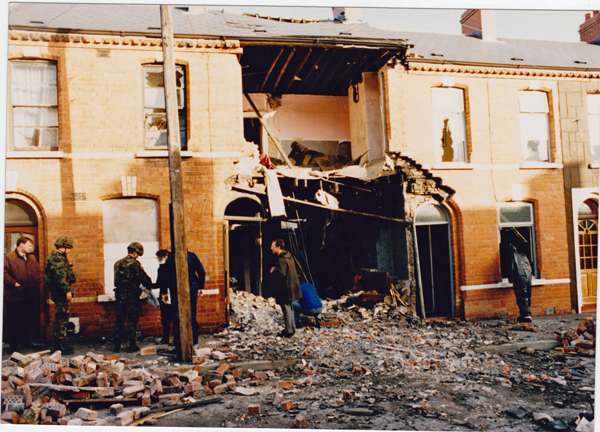
“Nothing to do with me Guv”!
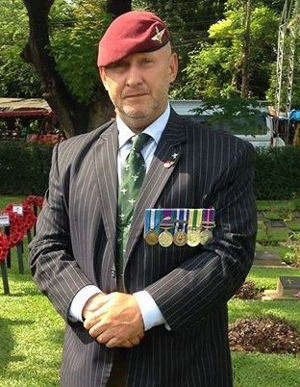
Above >>> Richard Stacey
Verzetsherdenkingskruis (V.H.K.) (Netherland’s Silver Cross (N.S.C.))
The Verzetsherdenkingskruis (the Dutch Resistance Memorial Cross or the Dutch Resistance Commemorative Cross) was instituted by Royal Decree on 19th December 1980, following the 35th anniversary celebrations of the liberation of the Netherlands. It was awarded to Members of the Dutch Resistance, who had opposed the German Army of Occupation during the Second World War. In England, due to its form and design, it is simply known as the Netherland’s Silver Cross (N.S.C.).
The medal comprises a silver hall-marked cross hung from a striped ribbon. The obverse of the cross bears the Dutch royal crown above a sword in flames. The dates 1940 - 1945 are engraved on the vertical element, and the inscription "De Tyranny Verdryven” ("To destroy tyranny") on the horizontal element. The reverse bears a Dutch lion. The ribbon is coloured with asymmetric stripes – the left half is red-white-blue (representing the Dutch flag) and the right half is orange (the national colour of the Netherlands) with a black border on each edge in memory of the brave fighters who died for the cause of freedom.
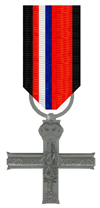
The following Brother was awarded the N.S.C.: -
Bro. K.D. Banwell 10 Para. F – 1990
Keith Deamer Banwell joined the British Army in 1936. initially serving with the Coldstream Guards and later with the Royal Hampshire Regiment. His career during the Second World War progressed through every form of Special Forces then in existence, beginning in 1942 when he joined the Long Range Desert Group. He was captured at Tobruk, but soon escaped in a German half-track and returned to the British lines. He later joined the Commandos and was captured during an operation on Crete, but once again succeeded in escaping, this time in a German landing-craft. He eventually arrived in North Africa after drifting at sea for over a week having run out of diesel. While he was recovering from exposure the Hospital Staff noticed his resemblance to General Montgomery and this led to him being driven around North Africa as Montgomery's double to confuse the German spies. As he was taller than the General, he was instructed to remain seated while in public view! Bored with this role, he joined the 10th Bn when the 4th Para. Brigade was formed in the middle-east.
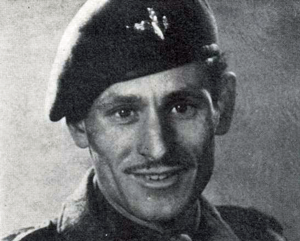
Above >>> Keith "Tex" Banwell
He was a Platoon Sergeant in A Company, 10 Para. when he took part in Operation Market Garden in September 1944. He was wounded and captured, but escaped while being transported by train to a Prisoner of War Camp, along with Lt Leo Heaps 1 Para. (a Canadian) and S/Sgt Alan Kettley Gl.P.Regt. The three escapees made contact with the Dutch Resistance and when the other two were evacuated across the Rhine to the Allied lines, Banwell volunteered to stay and act as a weapons instructor in order to teach the Dutch how to use the Bren guns that they had acquired, but had no idea how to operate. He adopted the code name “Tex” and was involved in several resistance ambushes on the occupying German troops. Eventually, he was again captured and flown to Berlin, where he was interrogated by the Gestapo. He refused to betray his comrades in the Resistance and faced two dummy firing squads before he was sent to Auschwitz Concentration Camp. There he was confined in a 6 foot square cage and survived four months on a starvation diet until he was liberated by the Red Army in March 1945. He had lost half his body-weight.
After the war, Banwell continued to serve in the army until the 1970's. He then joined the Post Office, and became a Special Constable. He continued parachuting as a hobby, and made his 1,000th jump from a Dakota over Ginkel Heath, Arnhem (formerly D.Z. - Y) on the 40th anniversary of the battle in September 1984 and his 1,001st and final jump ten years later on the 50th anniversary – he was then aged 77!
His wartime experiences were included in the book The Grey Goose of Arnhem, published in 1977 by Leo Heaps, the Canadian who had escaped with him. He was awarded the B.E.M. in the New Year’s Honours in 1969 and the N.S.C. was presented to him by the Mayor of Arnhem in 1982 – he is thought to be the only Member of the British Armed Forces to have received this award.
Legion d’Honneur (L.d’H.)
The rank of Chevalier of the Legion d’Honneur is open to men of all ranks and only merit or bravery count towards its award. The French Government conferred it on 100 selected D-Day veterans on 6 June 2004.
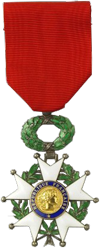
The following Brother was made a Chevalier of the Legion d’Honneur: -
Bro. R.A. Reiber 5 (Scottish) Para. J - 2001
The Ultimate Sacrifice
“Greater Love hath no man than this – that he lay down his life for his friends”.
New Testament – St John Ch.15, v.13.
******************************
“From this day to the ending of the World, But we in it shall be remembered – We few, we happy few, we band of brothers; For he today that sheds his blood with me Shall be my brother…”
Henry V, Act lV, Scene lll. – Shakespeare.
Service in the Armed Forces has always been a dangerous profession and the casualty figures for the First World War reveal the horrendous carnage associated with military action. However, not all deaths are the result of combat injuries. Prior to the Second World War and the introduction of antibiotic therapy, many died as a result of sepsis complicating relatively trivial wounds and the great epidemic diseases, such as cholera, typhoid, typhus and dengue fever also resulted in a significant number of deaths – indeed during the Crimean War they accounted for the majority.
However it wasn’t until the latter part of the First World War that #“Combat Stress” was eventually recognised as a serious complication of prolonged active service. At that time it was labelled as “Shell Shock”. Later studies by Military Psychiatrists led to it being re-designated as “Post Traumatic Stress Disorder”. Sadly, when not adequately treated, it leads to a significant number of suicides, who rightly should be considered as deaths associated with action.
The Member, who died at his own hand as a result of active service, appears in the list of Members under the general classification of “killed as a result of action” (kra).
Falklands War
Bro. S. Hood 2 Para. – took his own life in January 2013. I – 1996.
#Sadly not before many young men had been executed as cowards rather than treated for a serious psychiatric disability.
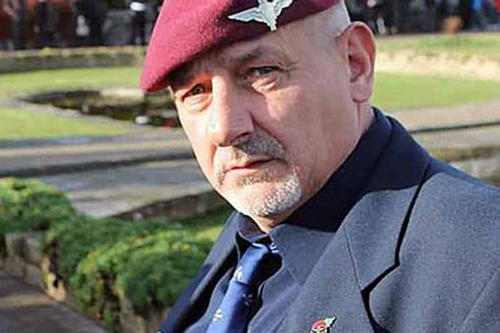
At the Coroner’s inquest held at Ruffin in North Wales on 28th June 2013 it was stated that Steve Hood had never fully come to terms with his experiences in the Falklands, despite earning his living in another stressful environment on the North Sea oil-rigs. At the end of 2012 the President of Argentina, Mrs Cristina Kirchner renewed her country’s claim to sovereignty over the Islands and this served to re-ignite his nightmares and flashbacks and eventually lead to his suicide.
A sad end to the life of a brave man.
“They shall not grow old, as we that are left grow old.
Age shall not weary them, nor the years condemn.
At the going down of the sun and in the morning,
We will remember them”.
“For the fallen” – Binyon.
Next page ... Family Tree